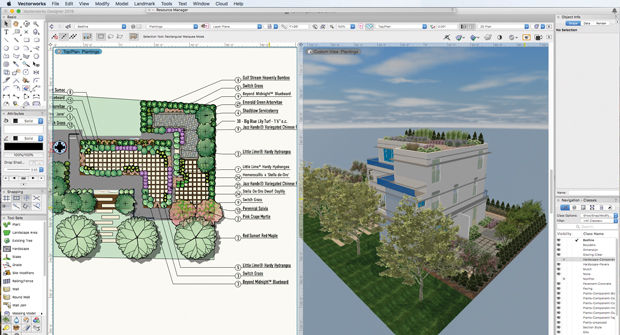
Landscape design/build companies know that these days, clients want to be able to view their designs in 3D and in some cases, be able to see them in virtual reality. “This provides the customer with a more interactive experience, whether or not someone’s going to be putting on the goggles and panning around into the site,” says Eric Gilbey, product marketing manager for Vectorworks. The global design and building information modeling software company offers the capability to view designs this way.
Additionally, Vectorworks can also generate a web-view link, which allows clients to view their design site and walk around in it, from their own devices, without the need for them to have the Vectorworks software.
Staying up to date with other software platforms is also key, according to David Sloan, marketing director for Drafix Software, the maker of Pro Landscape software. Though there are some longtime users of design software who aren’t super technical, it’s important for software companies to update frequently. AutoCAD, a design industry standard software (CAD stands for computer-aided design), updates yearly, so every year, Pro Landscape updates as well.
There’s also the all-important matter of material libraries. “One thing that people always ask me for is new items in the materials library, new items, new species of plants, so it’s about making sure that the database is in sync with new products,” Sloan says.
For Pro Landscape, $1,495 gives the user license to install the software on two computers and a tablet, 6.5 hours of tutorials and lifetime support. For Vectorworks Landmark, a perpetual license with priority technical support and immediate access to free versions is $3,715 or $3,045 for a perpetual license with basic tech support. Monthly and yearly “pay only what you need” U.S. subscriptions are available as well.
Software at work
Brad Curtis, designer/contractor at Landscape Management Service (LMS), based in Salt Lake City, Utah, has been a longtime user of Pro Landscape software. LMS focuses on landscape construction and maintenance, working directly with home developers and builders. It has 120 employees and brought in $10 million in revenue last year.
LMS purchased Pro Landscape 11 years ago and has since expanded its landscape and irrigation services.
“It’s been instrumental in producing millions of dollars of work for us,” he says.
One such project is Harmon Day Drive, a streetscape in Bluffdale, Utah. The designs allowed the company to secure the contract on the rest of the neighborhood, which will yield $500,000 worth of landscaping on single-family homes and town homes. The project will be completed this summer.
“The way I use the software starts from the very beginning of a conceptual design to a detailed landscape and irrigation plan,” Curtis says. “Whether I need to draw something from scratch or import a site plan from an engineered set of plans or do a material takeoff from a landscape plan provided, I have the options I need.”
Adding value
With the growth of extensive material libraries, apps that allow customization and job costing on-site, where do the experts see design software heading in the future?
Gilbey says one capability of the integrated 2D/3D Vectorworks Landmark software is site analysis.
“If you want to see solar shadow studies to make sure that you’re solving the sun or shade asks of the client, you’ve got the tools to do that now,” he says.
Vectorworks also includes tools for analyzing grade changes and ensuring there is positive drainage away from the structure.
“When (customers) recognize that you didn’t just design to check the boxes, but you did some analysis to prove your solution is the right one for their site, there’s value added there,” Gilbey says.

